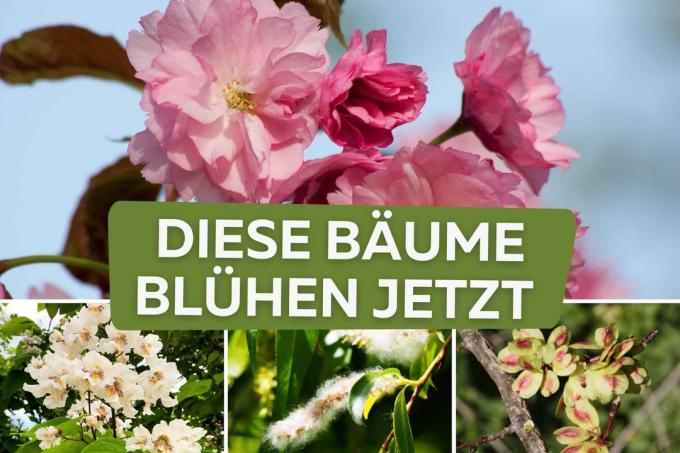
Flowering trees are an eye-catcher. In addition to a variety of colors, the flowers are presented in different shapes. By choosing the right variety, there are flowering trees in the garden throughout the season.
In a nutshell
- there are mainly early flowering trees
- early flowering trees are a good source of nectar for insects
- Coniferous trees, such as the mountain pine, still bloom in summer
- Figs flower late in the year and often do not bear fruit until the beginning of winter
- some trees that flower late should be protected from frost
Table of contents
- Early flowering trees
- Summer flowering trees
- Late flowering trees
- frequently asked Questions
Early flowering trees
Trees that flower early in the year are an important food source for some insects. Due to the early flowering, there is often a risk that the flowers will be destroyed by a frost.
African Tamarisk (Tamarix africana)

Not only the flower of the African tamarisk is attractive, but also the scale-like leaves with a grey-green colour.
- Growth height: 4 - 7 m
- Flowering period: March - June
- Flower color: pink
American Ripe Willow (Salix irrorata)

A feature of the ripe willow is that the younger shoots are covered with gray frost.
- Growth height: 3 - 4 m
- Flowering time: March - April
- Flower color: gray with yellow-orange stamens
balsam poplar (Populus balsamifera)

Balsam poplar originally comes from North America and is a popular wood for furniture.
- Growth height: 20 - 30 m
- Flowering time: March - April
- Flower color: green to green-yellow
Tree Rock Pear (Amelanchier arborea)
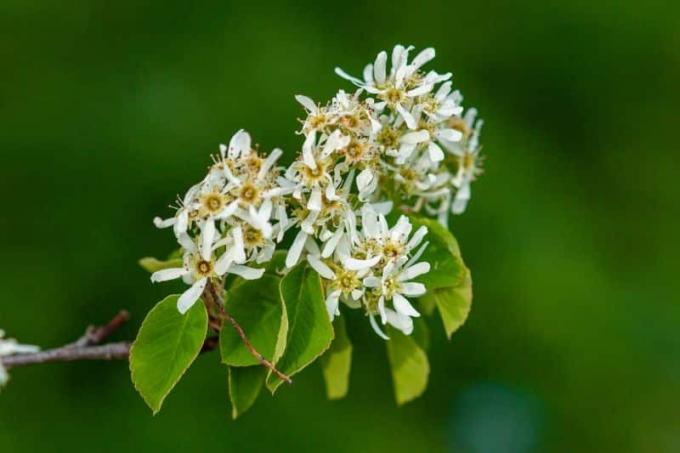
The tree rock pear is undemanding and suitable as a decorative solitary tree.
- Growth height: 15 - 20 m
- Flowering time: March - April
- Flower color: white to pink-white
tree hazel (Corylus colurna)

The tree hazel is an ideal tree for roadsides as the plants can cope with difficult soils.
- Growth height: 5 - 25 m
- Flowering time: March - April
- Flower color: yellow-brown male catkins, reddish female flowers
Norway elm (Ulmus glabra)
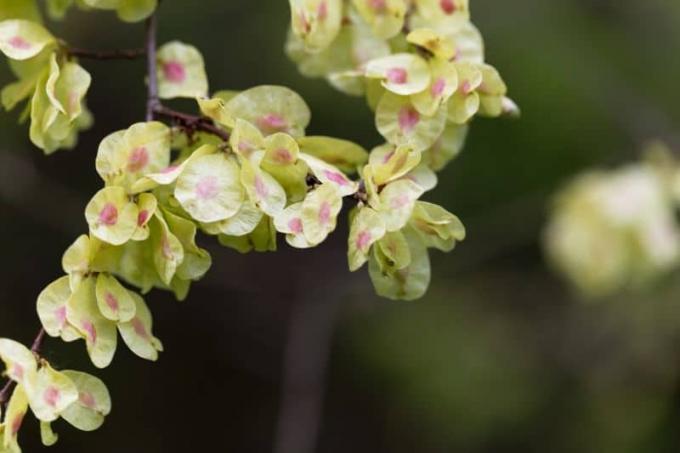
The leaf of the mountain elm can appear variable. Older leaves may have multiple terminal tips.
- Growth height: 4 - 30 m
- Flowering time: March - April
- Flower color: brown-black, yellowish stamens
birch-poplar (Populus simonii)

The birch poplar originally comes from Asia. It is a popular plant with bees in spring.
- Growth height: 3 - 25 m
- Flowering time: March - April
- Flower color: reddish catkins
Break Willow (Salix fragilis)

In the past, the wood of the willow was used for prostheses due to its low weight.
- Growth height: 6 - 25 m
- Flowering time: March - April
- Flower color: yellow to yellow-green catkins
Chinese Redwood (Metasequoia glyptostroboides)

With a growth rate of up to 60 cm per year, the tree quickly reaches an impressive size.
- Growth height: 3 - 40 m
- Flowering time: March - April
- Flower color: green-brown
Ash maple (Acer negundo)

The green-brown male flowers of the ash maple are particularly striking. They are grouped into large clusters.
- Growth height: 10 - 18 m
- Flowering time: March - April
- Flower color: green-brown or green-yellow
A notice: There are cultivated forms of the ash maple with variegated leaves. They have green-white or green-pink colors.
culture apple (Malus domestica)

The cultivated apple varies only in the fruit. The flowers are the same for all varieties.
- Growth height: 7 - 9 m
- Flowering time: April - May
- Flower color: white - pink-white
plum (Prunus domestica)

There are several subspecies of the plum, but they all have a white flower. Among them is the cherry plum (Prunus cerasifera), which produces smaller fruits in yellow, red or blue.
- Growth height: 8 - 10 m
- Flowering time: March - April
- Flower color: white
bird cherry (Prunus avium)

The wild cherry is the wild form of the cherry. It also produces edible fruits, but they are much smaller.
- Growth height: 18 - 25 m
- Flowering time: April - May
- Flower color: white
A notice: Ornamental forms of cherry blossom in pink.
Summer flowering trees
Summer-blooming trees are ideal for providing the guiding color for perennial beds. There are only a few native trees that bloom in summer, which is why hardy exotic trees are usually used.
Aleppo pine (Pinus halepensis)

The Aleppo pine is only partially frost-resistant. In sheltered locations, it usually survives the winter without damage.
- Growth height: 15 - 20 m
- Flowering period: May - June
- Flower color: green-white, later brownish
Alpine Laburnum (Laburnum alpinum)

The alpine laburnum was a popular ornamental tree. Because of his toxicity he disappears more and more from the gardens.
- Growth height: 4 - 5 m
- heyday: May June
- Flower color: yellow
American yellowwood (Cladrastis kentukea)
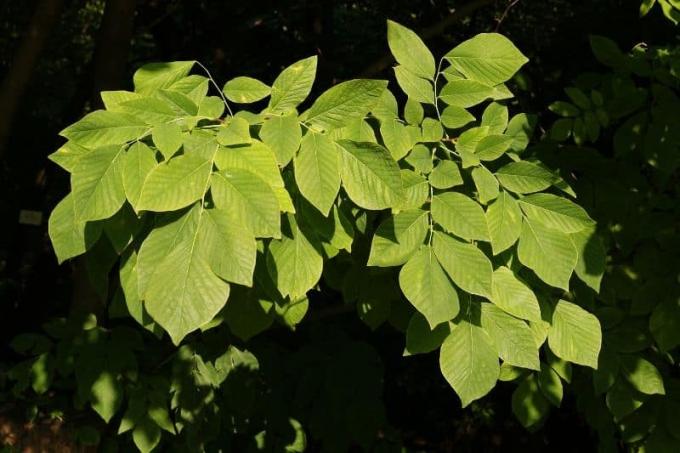
Inside, the wood of the yellowwood tree is beige to yellowish.
- Growth height: 7 - 15m
- Flowering period: May - June
- Flower color: white
American locust locust (Gleditsia triacanthos)

- Growth height: 10 - 20 m
- Flowering period: May - July
- Flower color: green-white
Andean fir (Araucaria araucana)

Compared to other conifers the Andean fir has strong scales instead of needles on the branches.
- Growth height: 6 - 25m
- Flowering period: June - July
- Flower color: yellowish
mountain pine (Pinus mugo)

In order for the mountain pine to get cones, a second tree is needed. The fruits only form through cross-pollination.
- Growth height: 3 - 4 m
- Flowering period: June - July
- Flower color: male flowers light brown, female flowers red
Blue elderberry (Sambucus nigra ssp. caerulea)
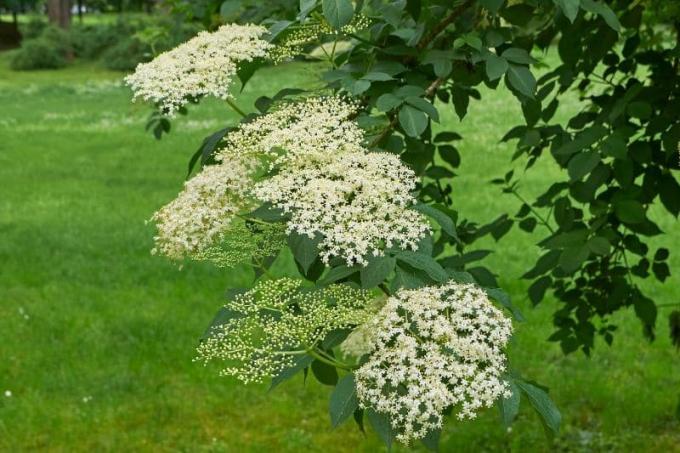
The blue elder is planted less for the flowers than for the attractive light blue fruit decoration.
- Growth height: 10 - 15 m
- Flowering period: June - July
- Flower color: white
Bunge's trumpet tree (Catalpa bungei)
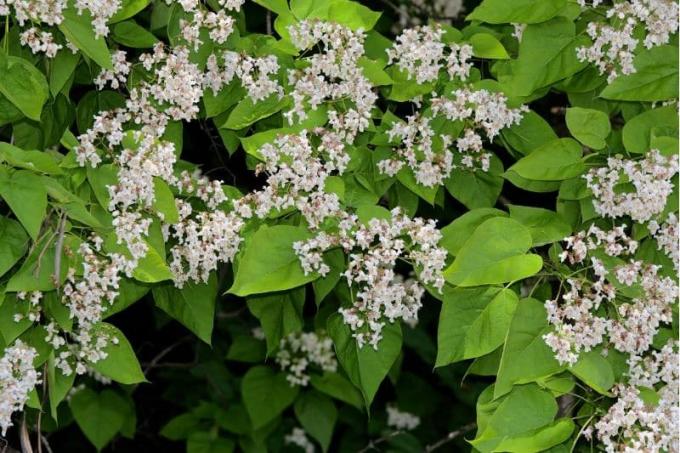
The Bunges trumpet tree originally comes from Mongolia. It is resistant to extreme heat and cold.
- Growth height: 10 - 15 m
- Flowering period: June - July
- Flower color: pink-white
Late flowering trees
Late flowering trees say goodbye to the year with single flowers. The selection of late-blooming trees is limited, but late-blooming shrubs can also be trained into small trees.
Atlas cedar (Cedrus atlantica)

The Atlas cedar has been a popular ornamental tree since ancient times.
- Growth height: 20 - 35 m
- Flowering period: September - October
- Flower color: red-green to brown-red
A notice: The Blue Atlas Cedar (Cedrus atlantica) also blooms late in the year. She has blue-green needles.
Chinese elm (Ulmus parvifolia)

Although the Chinese elm is frost-resistant, it is not yet widespread in Europe.
- Growth height: 15 - 25 m
- Flowering period: August - October
- Flower color: white to white-green
Thorny Oleaster (Elaeagnus pungens)

The thorny oleaster is conditionally frost-resistant. It survives the winter outdoors well with a frost protection.
- Growth height: 3 - 4 m
- Flowering period: September - October
- Flower color: white
Real fig tree (Ficus carica)

The real fig must be protected from frost in the first few years. Older trees usually no longer need protection from frost.
- Growth height: 3 - 12 m
- Flowering period: August - September
- Flower color: green
Shiny privet (Ligustrum lucidum)

The glossy privet is better known as a hedge plant. If the privet is not pruned, it can develop into an attractive tree.
- Growth height: 8 - 10 m
- Flowering period: August - September
- Flower color: white to yellow-white
winter cherry (Prunus subhirtella f. autumnalis)
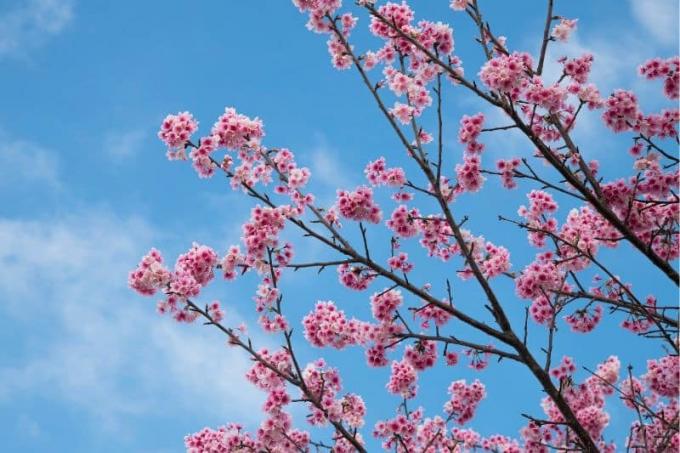
Only in mild winters does the winter cherry bloom late in the year. The main bloom is usually from March to April.
- Growth height: 3 - 7 m
- Flowering time: November - April
- Flower color: white to pink-white
frequently asked Questions
No, most trees do not flower twice a year. With young ornamental trees, it is advisable to remove the faded flowers so that they do not put their energy into seed formation but into growth.
In the case of fruit trees, it makes sense to protect them from frost during the main flowering period so that they produce fruit. With ornamental trees, the effort is usually too great.
With the exception of a few conifers, it is important for securing the stock of trees that they can still fully develop their fruit until winter. Conifers can protect their fruits over the winter, which is why they often only mature the following year.
